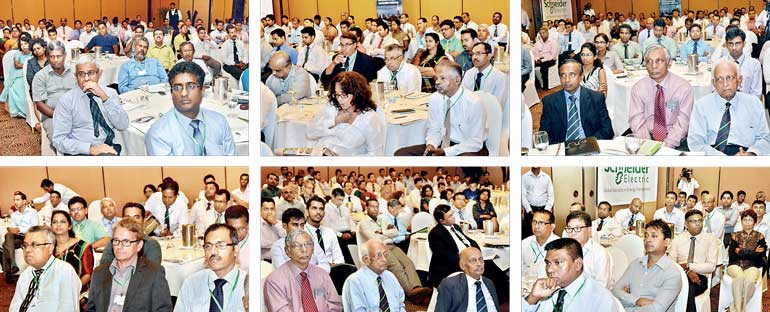Thursday Apr 25, 2024
Thursday Apr 25, 2024
Wednesday, 2 September 2015 00:00 - - {{hitsCtrl.values.hits}}


By Himal Kotelawala
Electrification of suburban railway tracks on the existing network is likely to occur within the next three to four years, Senior Engineering Consultant Dr. Tilak Siyambalapitiya said.
Speaking at a conference on Electro Mobility and Urban Mass Transportation organised by the Institute of Engineering and Technology (IET) last week, Dr. Siyambalapitiya revealed plans by the government to electrify the 63.4km stretch of railway track between Panadura and Veyangoda.
The total track length between Panadura and Veyangoda is 156km, and serves 44% of all railway passengers on a given day. Under the proposed system, Dr. Siyambalapitiya said in his presentation, an overhead catenary wire will supply 25kV power to a dedicated electric multiple unit (EMU) train, while the rails will function as a return wire.
Existing diesel power sets and other trains, meanwhile, can continue to operate on the same tracks. The estimated total minimum cost of the project, if implemented, will be $ 29.4 million.
According to Dr. Siyambalapitiya, further studies have been approved based on a Cabinet Paper submitted by the Ministry of Power and Energy and the Ministry of Internal Transport in July. The Asian Development Bank has also expressed willingness to fund a detail feasibility study and a steering committee has been appointed, he said.

A test run has already been carried out from Dematagoda to Ragama and the time duration of operation of each throttle was recorded to be about 4.37 kilowatt hours per EMU per kilometre.
In comparison, said Dr. Siyambalapitiya, this figure for slow trains operating in Taiwan is 7.6kWh/EMU-km while the same for express trains in Sweden is 8.2kWh/EMU-km. This is due to the fact that high speed trains consume more energy to overcome wind resistance. If you turned off the air condition, he added, energy consumption drops to just 5.5kWh/EMU-km.
According to Dr. Siyambalapitiya’s calculations, adopting this technology would drop present railway energy costs significantly. A diesel engine train, at present, has an energy consumption of 2.5 litres per kilometre at a Rs. 95 per litre, resulting in an energy cost of Rs. 237.50 per kilometre.
On an electric train, with an energy consumption of 5.5kWh/EMU-km at Rs. 19.48/kWh, the cost would be just Rs. 107.14 per kilometre – less than half that of a diesel train.
Explaining the costs, Dr. Siyambalapitiya said that electricity tariff for the operation of this service will be determined thus: Electric trains will not operate at peak hours; Sri Lanka Railways (SLR) will directly purchase electricity from the transmission network (132kV); traction grid substations and distribution system will be maintained by SLR; energy will flow back to the grid with regenerative braking; harmonics will be added to the system.
Elaborating on the advantages of an electrified train service, Dr. Siyambalapitiya said it could reduce running costs by approximately 70%. It can also allow for greater speeds, with higher acceleration and deceleration, higher average speed and a low turn-around time. Overall fuel efficiency will also be higher, he said, and there will be no power loss when waiting at railway stations. Regenerative braking will recycle energy back to the grid when slowing down the train, he added.
Electric trains are also environmentally friendly, as there will be no emissions at stations, reduced noise and no oil spills.
Maintenance costs are lower as well (about 50%) with shorter downtime for maintenance, said Dr. Siyambalapitiya. Passenger comfort is also higher due to reduced noise and vibration, he explained. Air condition can also be provided.
Another benefit of an electric train service, according to Dr. Siyambalapitiya, is its possible contribution to the national grid. It can assist in filling what he called the two “valleys” in the country’s load profile, from 6.30am to 8.30am and 5.30pm to 7.00pm, resulting in the lowest possible production cost for the Ceylon Electricity Board (CEB) to supply power to the railways. Additionally, it will improve the load factor, with better use of generation and transmission equipment.
The implementation of this project and the actual construction of it will not be without its challenges. The power supply would have to be constructed and electric infrastructure such as grid substations and overhead lines would have to be laid while the existing system is still in operation. Several high voltage, medium voltage and low voltage lines cross the rail track and therefore requires proper clearance and protection, said Dr. Siyambalapitiya.
Before construction safety clearance at road passes, passenger bridges at stations and station roofs would have to be improved, he added.
Other track and right-of-way improvements would be to resolve clearances and encroachments to allow higher speeds.
Signalling would also have to be improved with modifications to match higher speeds and to allow one rail to be used for the return power conductor. Height restrictions would have to be enforced at level crossings, he warned.
There are two options when acquiring electric trains for the project, explained Dr. Siyambalapitiya: buy EMUs instead of diesel power sets at almost the same price, or convert existing diesel power sets to run on the electric system. The latter option is not recommended, he said.
A feasibility study for this project would cost $ 1.1 million. If implemented, $ 26 million would have to be spent on power lines and other related infrastructure and a further $ 2.3 million for track modification and way leaves, bringing the total cost to an estimated minimum of $ 29.4 million.
The feasibility study is to be carried out later next year, with the establishment of a project implementation unit or company. The actual implementation will begin following the preparation of specifications with details and a tendering process.
Pix by Upul Abayasekara